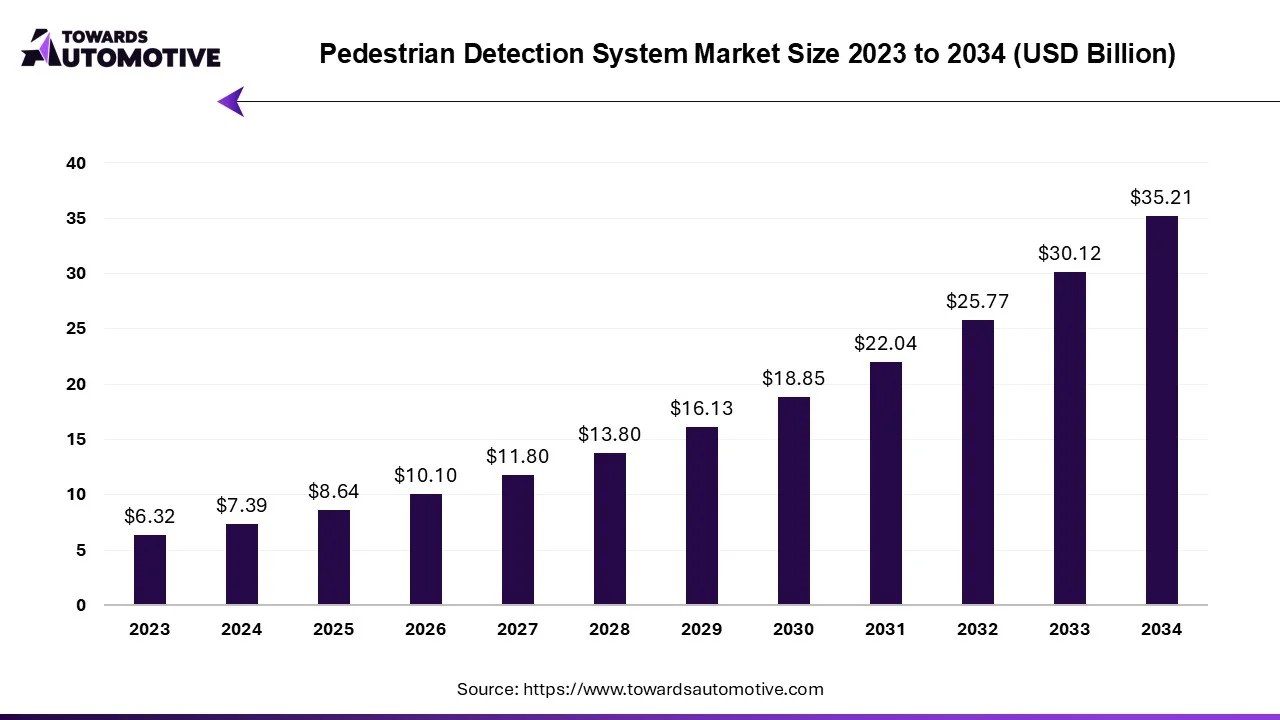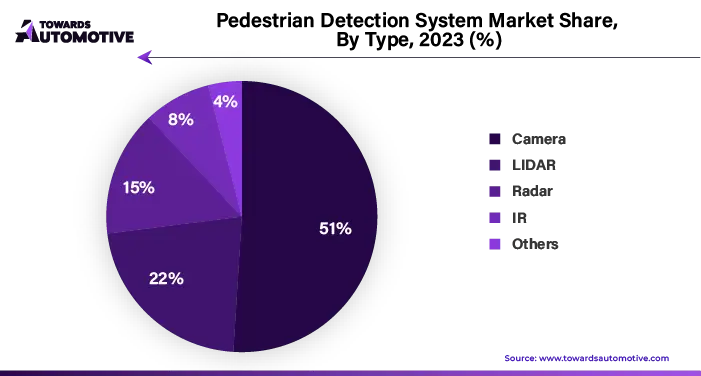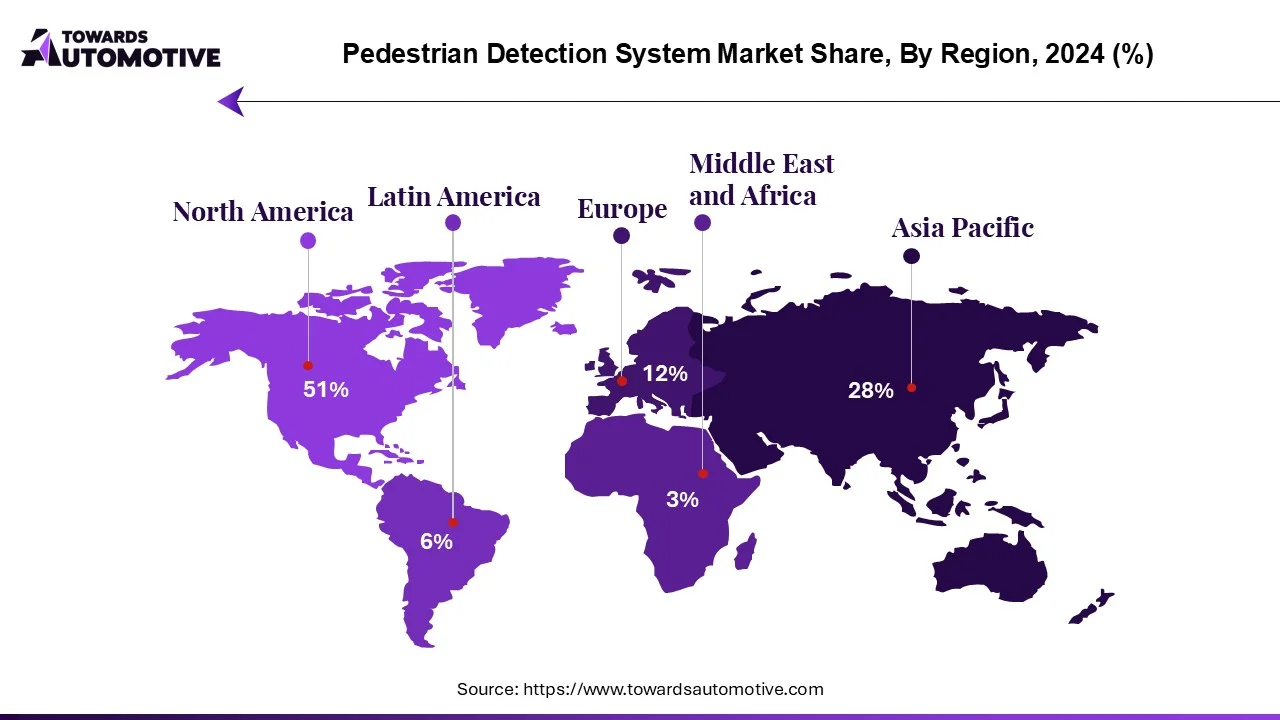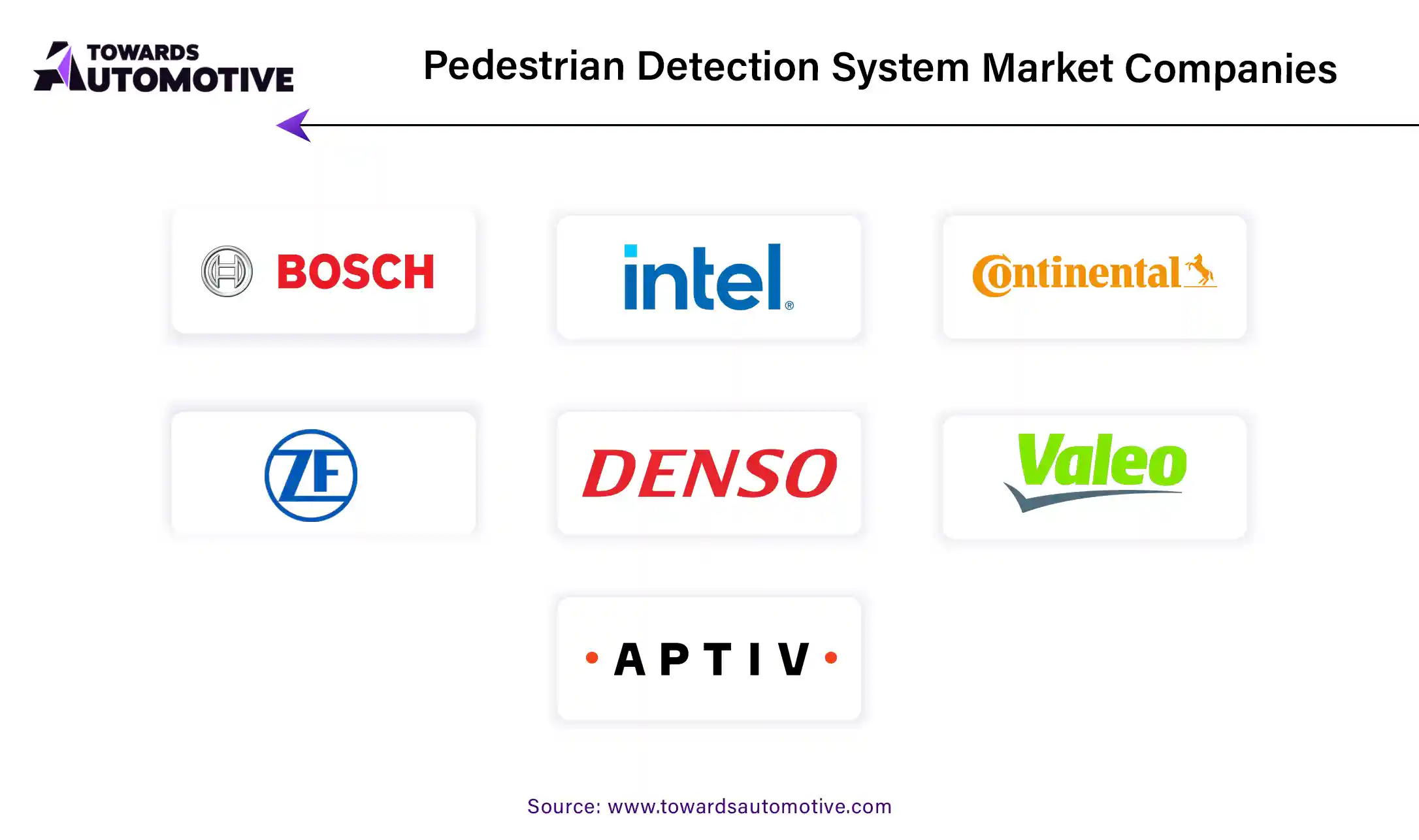October 2025
The pedestrian detection system market is forecasted to expand from USD 8.64 billion in 2025 to USD 35.21 billion by 2034, growing at a CAGR of 16.90% from 2025 to 2034.

The rising incidence of pedestrian and vehicle accidents, coupled with the rapid urbanization witnessed globally, has heightened concerns regarding road safety. In response, governments are implementing stringent regulations mandating the inclusion of pedestrian detection systems in vehicles. Concurrently, there's a surge in consumer demand for enhanced safety features, propelling the growth of the pedestrian detection system industry.
Moreover, with the advent of autonomous vehicles, the significance of pedestrian detection systems has escalated. These systems play a pivotal role in ensuring the safety of pedestrians and other road users amidst the dynamic and evolving urban landscape. Advanced Driver Assistance Systems (ADAS), which encompass pedestrian detection capabilities, have emerged as crucial components in the pursuit of a viable market for autonomous vehicles. Manufacturers are increasingly integrating ADAS technology, including pedestrian detection systems, into vehicles to bolster safety features.
Consumers' growing interest in ADAS-equipped vehicles, driven by their concerns regarding road safety, has spurred automobile manufacturers to prioritize the incorporation of these features into their vehicles. As ADAS technology continues to advance, pedestrian detection systems are becoming more accurate and affordable, fostering greater demand and adoption within the automotive industry.
However, the efficacy of pedestrian detection systems hinges on their ability to minimize false alarms and false positives. False alarms occur when the system erroneously identifies non-pedestrian objects or shadows as pedestrians, leading to unnecessary or distracting alerts. Conversely, false positives arise when the system fails to detect actual pedestrians, resulting in missed warnings or potential accidents. Striking a delicate balance between sensitivity and specificity is paramount to mitigate both types of errors, thereby instilling trust in the system's reliability and ensuring its effectiveness in real-world scenarios.
Pedestrian detection systems represent a crucial advancement in automotive safety technology, addressing the pressing need to mitigate pedestrian-related accidents and fatalities. As these systems continue to evolve and improve, their widespread adoption holds the promise of significantly enhancing road safety and fostering a safer and more sustainable urban mobility landscape.
The COVID-19 pandemic has cast a shadow over the travel industry, triggering a cascade of adverse effects that have reverberated across various sectors, including vehicle safety technologies such as pedestrian detection systems. Lockdown measures, economic instability, and plummeting vehicle production and sales have collectively dampened the demand for and utilization of these safety features.
Supply chain disruptions and decreased consumer spending have dealt a double blow to businesses, slowing down demand for vehicle safety technologies, including pedestrian detection systems. With economic uncertainties looming large, companies have scaled back their investments in such technologies, prioritizing immediate cost-cutting measures over long-term safety enhancements.
Furthermore, the shift towards remote work arrangements and reduced travel has reshaped consumer behavior, diminishing the sense of urgency surrounding vehicle security. As individuals spend less time commuting and traveling, the need for advanced safety features has taken a backseat, creating a fiercely competitive market landscape for suppliers vying for a shrinking pool of customers.
In this challenging environment, businesses operating in the vehicle safety technology sector must navigate through unprecedented uncertainties while devising innovative strategies to adapt to the evolving needs and preferences of consumers. Despite the prevailing challenges, there remains a glimmer of hope for the resurgence of demand as economic conditions stabilize and the travel industry gradually rebounds from the impacts of the pandemic. However, until then, stakeholders in the vehicle safety technology sector must remain vigilant and agile in navigating the turbulent waters ahead.
AI crosswalks represent a revolutionary advancement in pedestrian safety technology, poised to drive significant growth in the pedestrian detection industry. These innovative systems leverage artificial intelligence to detect pedestrians at intersections, thereby enhancing traffic flow efficiency and reducing the risk of accidents.

By harnessing the power of AI, crosswalks can intelligently identify pedestrians entering or crossing intersections, allowing traffic signals to dynamically adjust to accommodate pedestrian movement. This proactive approach not only improves pedestrian safety but also contributes to smoother traffic flow and reduced congestion.
A notable example of this technology in action is the collaboration between Dubai Silicon Oasis, a subsidiary of the Dubai Integrated Economic Zone (DIEZ) Authority, and Derq, a developer of intelligence-based traffic management solutions. In August 2023, they announced the deployment of 14 AI-powered smart pedestrian systems across Dubai Silicon Oasis. This implementation underscores the growing recognition of AI crosswalks as a viable solution for enhancing urban safety infrastructure.
As demand for pedestrian safety solutions continues to rise, companies are investing in the development and refinement of these intelligent systems. This trend presents significant business expansion opportunities within the pedestrian detection industry, as municipalities and urban developers seek to create safer and more pedestrian-friendly environments.
In addition to fostering business growth, AI crosswalks contribute to the realization of the vision of a safer and more sustainable city. By leveraging advanced technology to enhance pedestrian safety, these systems play a crucial role in building smarter, more resilient urban landscapes that prioritize the well-being of all road users.
Overall, the proliferation of AI crosswalks represents a transformative step forward in pedestrian safety technology, offering a promising pathway towards safer and more efficient urban mobility. As these systems continue to evolve and gain widespread adoption, they will undoubtedly play a central role in shaping the future of urban transportation infrastructure.
The pedestrian detection market is set for a transformative shift by 2023, with the electric segment poised to dominate the landscape. These systems offer enhanced safety measures by providing reliable detection of pedestrians even in low-light conditions, significantly augmenting pedestrian safety, particularly during nighttime travel.
One of the key drivers behind the surge in demand for pedestrian detection systems is the advancement in thermal sensor technology. These sensors play a pivotal role in improving the efficiency and effectiveness of Pedestrian Autonomous Emergency Braking (PAEB) systems, especially in challenging traffic scenarios. The escalating adoption of thermal sensors underscores their critical role in addressing nighttime pedestrian safety concerns.
Moreover, the evolution of camera technology is another significant contributor to the growth of the pedestrian detection market. Deep learning algorithms and convolutional neural networks have revolutionized camera-based pedestrian detection, enhancing their effectiveness across diverse lighting and environmental conditions. This advancement positions cameras as the preferred choice for pedestrian detection, particularly in advanced driver assistance systems (ADAS). Their high resolution and cost-effectiveness make them invaluable assets in the market, driving their widespread adoption.
Convergence of thermal sensor and camera technologies is reshaping the pedestrian detection market, ushering in a new era of enhanced safety and efficiency on the roads. As these technologies continue to evolve and become more sophisticated, they will play an indispensable role in mitigating pedestrian-related accidents and fostering safer urban mobility ecosystems.
The North American pedestrian detection technology market is poised for substantial growth, with projected revenue reaching approximately USD 3.5 billion by 2023. This surge in market value is driven by mounting concerns over pedestrian and vehicle accidents in the region, sparking heightened attention to traveler safety.

The United States and North America at large have witnessed a troubling rise in pedestrian fatalities, underscoring the urgent need for effective solutions to mitigate accidents. These tragic incidents have prompted a collective call for stricter safety measures and innovative technologies aimed at enhancing pedestrian safety on roadways.
In response to these pressing safety concerns, travelers are increasingly turning to vehicles equipped with pedestrian detection systems and leveraging urban infrastructure designed to prioritize pedestrian safety. These systems play a vital role in reducing pedestrian fatalities by detecting and alerting drivers to the presence of pedestrians, thereby mitigating the risk of accidents.
Government regulations and safety initiatives further bolster the deployment of pedestrian detection systems, emphasizing their critical role in saving lives and reducing accidents. By mandating the integration of advanced safety technologies into vehicles and promoting infrastructure improvements, policymakers are actively working to enhance road safety and protect vulnerable road users.
North American pedestrian detection technology market is poised to experience robust growth as stakeholders across the region prioritize pedestrian safety and seek innovative solutions to address the escalating number of pedestrian accidents. Through collaborative efforts between government agencies, automotive manufacturers, and urban planners, pedestrian detection systems are poised to play a pivotal role in creating safer and more sustainable transportation environments for all.

Major companies operating in the pedestrian detection system market are:
By Component
By Type
By Geography
October 2025
October 2025
October 2025
October 2025
We offer automotive expertise for market projections and customizable research, adaptable to diverse strategic approaches.
Contact Us